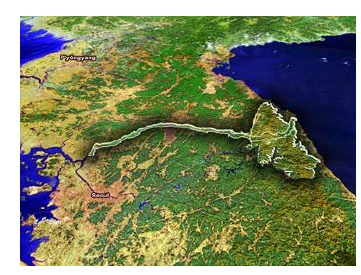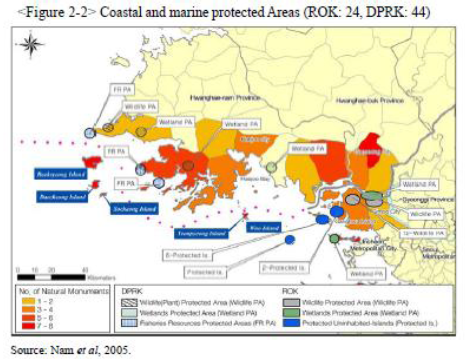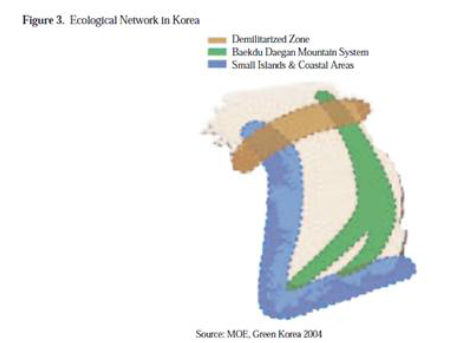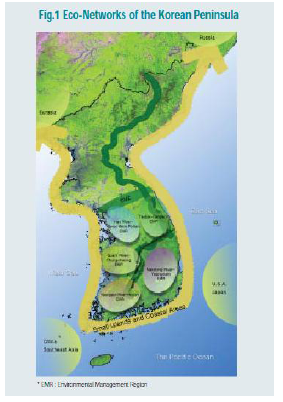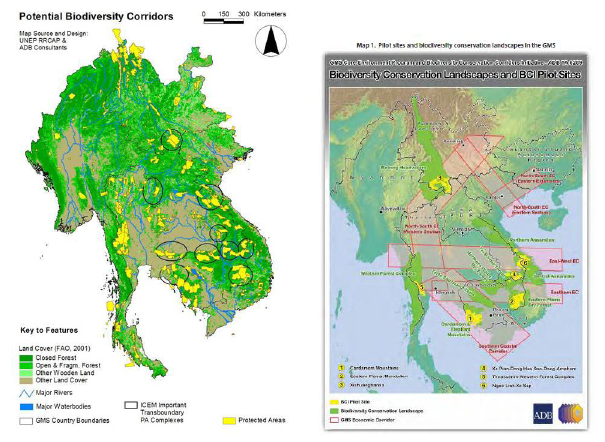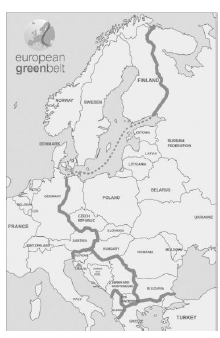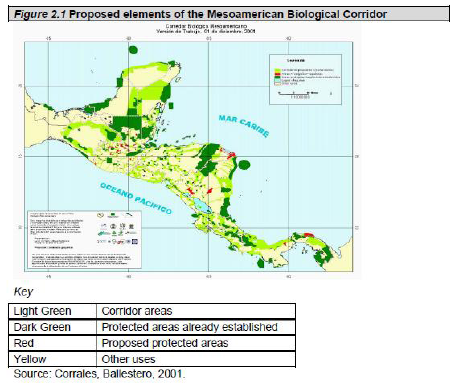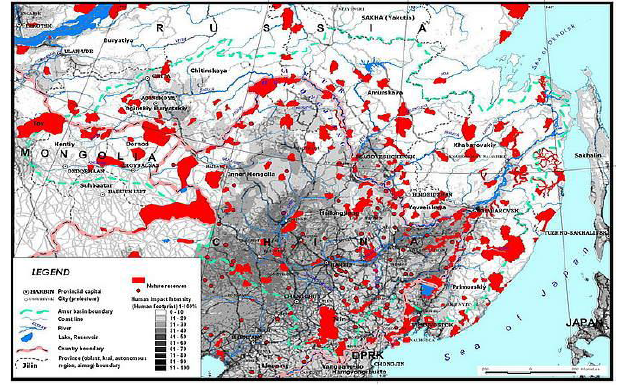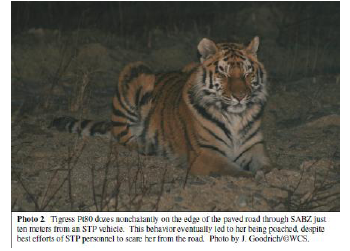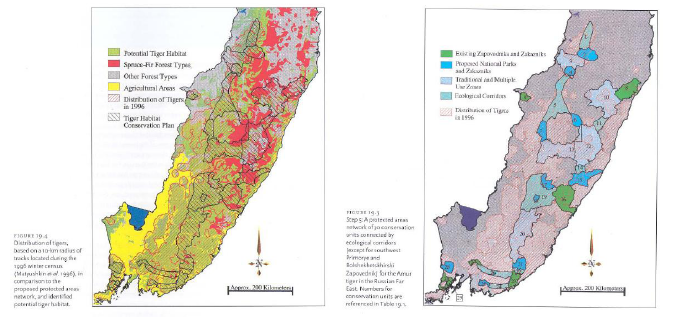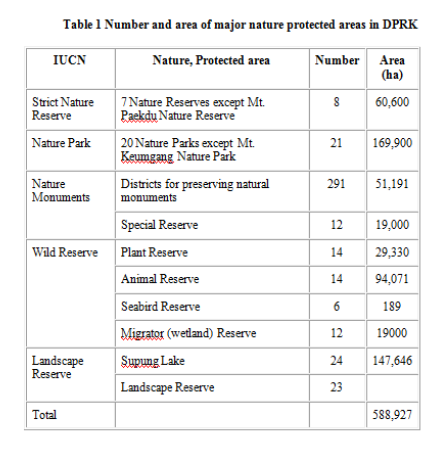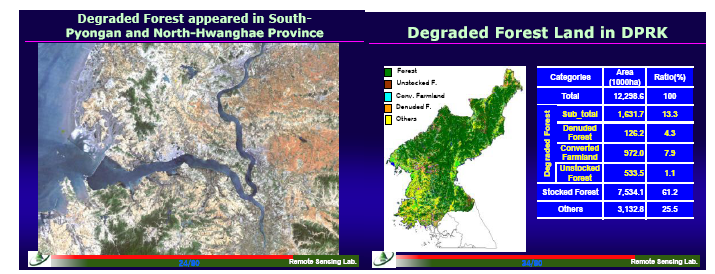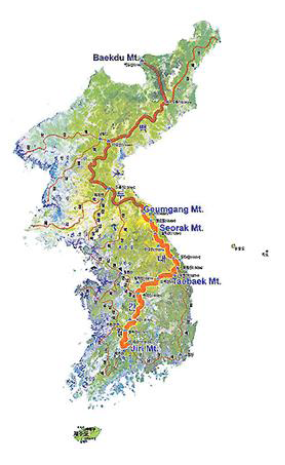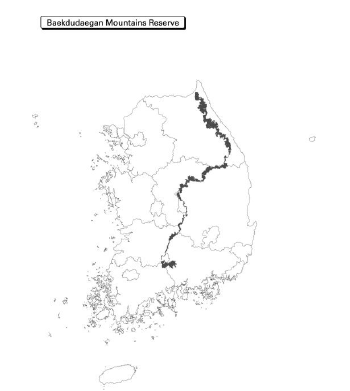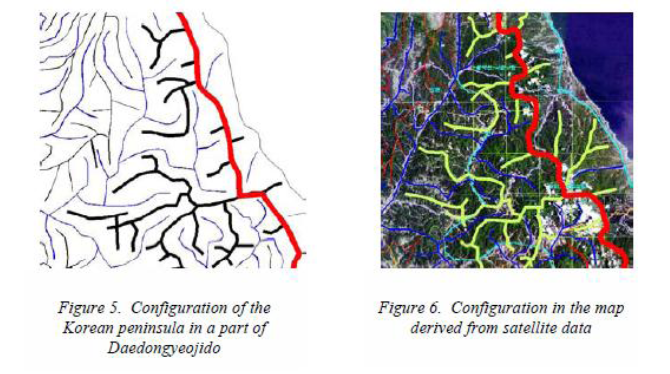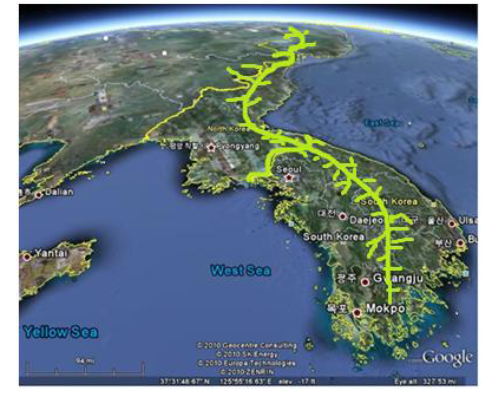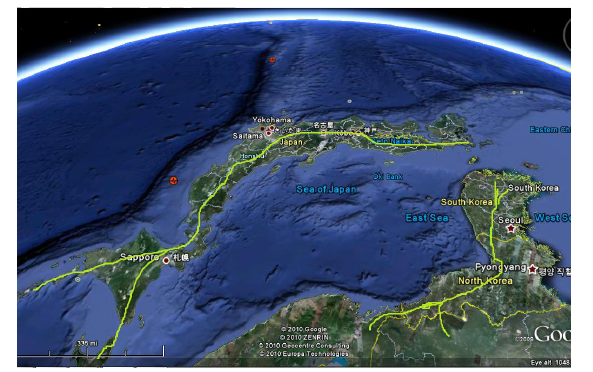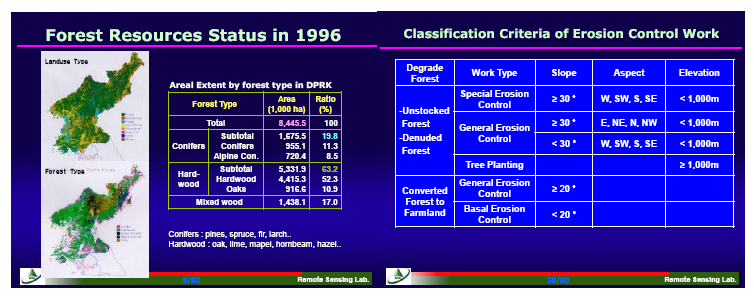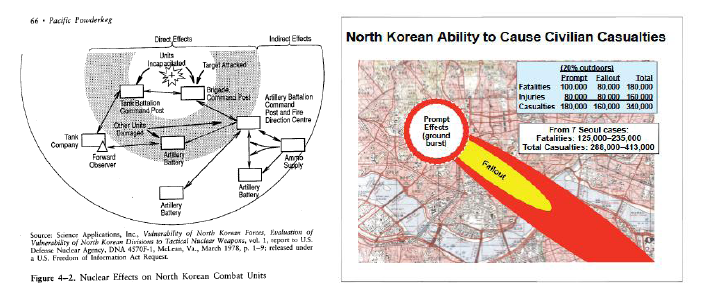Sustainable Security in the Korean Peninsula: Envisioning a Northeast Asian Biodiversity Corridor
Policy Forum 10-047: August 24th, 2010
Peter Hayes
This Policy Forum is a keynote speech delivered at the Korean Association of International Studies, 2010 DMZ Peace Congress, “Green Cooperation for Peace and Life,” in Seoul on August 12, 2010, and forthcoming in their Korean Journal of International Studies.
——————–
CONTENTS
I. Abstract
II. Article by Peter Hayes
III. References
IV. Nautilus invites your responses
This paper proposes the creation of a Northeast Asian Biodiversity Corridor (NEABC) that would connect in a consistent manner critical habitat in Russia, China, and the Korean Peninsula. Such a corridor may be considered now because of decades of scientific and policy work to establish a DMZ Peace Park, a mountain-watershed ecosystem network in the ROK, nature reserves in the DPRK, and cross-border mega-species migration corridors between the DPRK, China, and Russia. The paper reviews each of these stepping and foundation stones, and refers to proposed regional biodiversity corridors in other regions. It emphasizes parallels between the Northeast Asian context and that of the Mesoamerican Biological Corridor (MBC), an existing regional biodiversity corridor which involves eight Central American countries that like the two Koreas, are trapped in inter-state conflicts. It suggests that the Korean traditional concept of “The Baekdudaegan” that integrates the cultural and ecological landscapes of the mountains and rivers of Korea may be an important cultural device that frames the ecological basis of a regional NEABC. The paper reflects on how indirect and incremental social and political engagement may be a necessary attribute of strategies that build ecological security in a conflict zone. It concludes by contrasting this approach to the characteristics of what the author terms “nuclear insecurity” and suggests that a Northeast Asian Nuclear Weapon Free Zone may be a form of nuclear insecurity that relies less on balances of terror, and thereby is more conducive to the creation of sustainable security in this region.
The views expressed in this article are those of the author and do not necessarily reflect the official policy or position of the Nautilus Institute. Readers should note that Nautilus seeks a diversity of views and opinions on contentious topics in order to identify common ground.
-“Sustainable Security in the Korean Peninsula: Envisioning a Northeast Asian Biodiversity Corridor”
By Peter Hayes 1
INTRODUCTION: STATES OF INSECURITY
Two decades after the end of the Cold War, Korea remains trapped in a set of mutually reinforcing security dilemmas. These are partly driven by geopolitical circumstances whereby great powers continue to exercise influence over the two Koreas. These external powers aim to realize their own interests in Korea by exercising diplomatic and military power in response to the DPRK’s nuclear breakout on the one hand, and by attempting to pursue their divergent interests with respect to the future of the Peninsula with regard to such concerns as territorial disputes, resource management, military deployments, crisis management, etc., on the other.
In this manner, global concerns such as the nuclear non proliferation regime, the maintenance of the United States’ reputation as nuclear hegemon, Sino-Japanese hostility, Sino-US distrust and the Taiwan Straits issue, and Russia’s desire to participate in regional security and development schemes are all super-imposed on and shape the fundamental insecurity that dominates Korea, that is, its division by war and a long standoff between the two Koreas. These external drivers over-determine the complex set of inter-Korean relations, and make it almost impossible to align the internal and external variables that influence progress or regress in inter-Korean relations. When domestic Korean political and economic variables are added to the conflict equation, especially the isolated nature of the DPRK regime, and the volatility of the ROK’s democratic polity, it is almost certain that one or other of the critical external variables is out of alignment at the brief moments when the two Koreas are able to accommodate each other or render periods of inter-Korean rapprochement short and often brutal in their termination.
The outcome of this complex situation is grimly predictable. Both Koreas conceive of security as a zero sum game played primarily in military terms, as embodied in the huge military forces sustained by both Koreas, and disproportionately so relative to their populations and GNP in both cases. The clashes of conventional forces in the western seas over many years, and the DPRK’s presumed despicable covert operation to attack the Cheonan in March 2010, are indicative of this incredible state of affairs whereby in 2010—the “Year of the Tiger”—Koreans are still killing each other.2 Indeed, today South Koreans are forbidden by their government to even talk to North Koreans, even in third countries on an informal basis while North Koreans who favor engagement with the outside world are battered by political re-education and dispersed in purges to far flung corners of the DPRK and beyond. Thus, both states now live with a high level of insecurity. The recent eruption of nuclear weapons and threats represents the resurgence of the Old Guard in Korea, following Cold War conventions, procedures, and routines derived from the concept of containment.
In this conflict, both Koreas rely psychologically on nuclear threat projected at the other. The ROK obtains this effect by virtue of US extended nuclear deterrence from US nuclear forces now maintained far over the horizon. Although the language used in the US Nuclear Posture Review in April 2010 was more clinical than the flamboyant, flame-throwing nuclear threats spewing from Pyongyang, it is no less lethal in intention.
Let me be clear here: nuclear explosions do not only destroy soldiers and civilians in huge numbers in a few seconds. They destroy everything—weapons, buildings, plants, animals, insects, the entire cultural landscape, for all time. Robert Jay Lifton documented the ever-lasting nature of the devastation from their first-use in Hiroshima and Nagasaki in his study of survivors of those attacks.3 Korean survivors of these nuclear explosions also declare that nuclear war destroys all living things and eradicates the meaning of life for those who survive.
As Mrs. Kim Jeong-soon, a 27 year old mother who survived the Nagasaki nuclear explosion on her first visit in search of food for her baby told me in 1988 by which time she was a seventy year old street vegetable vendor, “If nuclear war happens in Korea, almost all the people will die, with only a few exceptions. But even they will all be crippled and will suffer.” 4
Moreover, the US nuclear threat to the DPRK is far more realistic in potential realization than the DPRK nuclear threat towards the United States, due to the former’s possession of hundreds of usable long-range nuclear warheads that could—so far as Pyongyang knows—be used to annihilate the DPRK without warning. In contrast, the DPRK would have great difficulty in reliably delivering a nuclear detonation beyond its own borders at this time. Their most likely actual potential use by North Korea may well be as land mines before or during a war. Nonetheless, its decision to employ exterminist nuclear rhetoric and even to threaten nuclear attack on South Korea should be denounced for what it is–nuclear aggression of the worst kind, aimed as it is against Koreans, one’s own kith and kin.
That we should be talking about the possibility of nuclear next-use in Korea today is shameful, a revelation of the true state of insecurity in Korea, and the failure of nearly six decades of leadership of all the states party to the Korean conflict to do more than avoid the resumption of war.
Is it really conceivable that this is the best that could be done by the Old Guard over the last two generations—that mutual deterrence should be the basis of inter-Korean relations?
In my view, the answer to that question is a resounding No! This paper is devoted to explaining why not.
In this paper, I will take a methodologically unconventional approach to addressing this issue. I hope by the end of the paper, you will see why I have taken this tack. If thinking, planning, researching, developing, testing, refining, deploying, threatening to use, and using nuclear weapons is the ultimate abdication of what it is to be human by virtue of the barbaric outcome of nuclear war, then its antithesis should reveal much about what might constitute an authentic peace-making strategy, one that would render nuclear war needless and useless, and lead to the eventual sheathing and abolition of all nuclear weapons in Korea. What is this antithesis?
The antithesis of making nuclear war is restoring the human environment. Habitat, the spatial form of natural life that provides the necessary global and local environmental services upon which all human beings depend, is the natural cathedral in which we live. Habitat contains the essential biological diversity that is a critical attribute of the ecosystems that sustain us. Passing onto future generations the ecological basis of human existence and culture is the most powerful action that any human society can take. Achieving this outcome is also one of the most difficult of human endeavors today due to the multiple and interacting problems of poverty, distributional inequity, knowledge deficits, institutional shortfalls, and the sheer complexity of decision-making in the face of accelerating uncertainty. This is the agenda of the New Guard in this region, often led by Koreans, who have cosmopolitan identities, and seek common solutions based on engagement, not containment. In security terms, this approach seeks to substitute NEWMAD—or what some have called Mutual Assured Dependence—embodied in the form of ecological interdependence—for OLDMAD, or Mutual Assured Destruction based on reciprocal nuclear threat.
In this paper, therefore, I reflect upon what it will take to realize sustainable security in Korea and its immediate neighbors, that is, security defined as preserving, conserving, and restoring the ecological basis of Korean identity.
I. STARTING STEPS: DMZ PEACE PARK AND ROK ECOLOGICAL AXES
In this section, I review some of the concepts that have been advanced that precede my proposal for a regional biodiversity corridor in Korea.
DMZ Peace Park: Pioneered by the DMZ Forum,5 the concept of establishing a DMZ peace park has been developed in-depth. This park would preserve the biological assets of the Demilitarized Zone, the areas that are well preserved in the adjacent areas with controlled civilian access and therefore relatively light ecological degradation since the Korean War, and in an expanded area at the eastern coastal end of the DMZ to encompass important established nature reserves on both sides of the DMZ. The essence of the DMZ peace park concept is captured in Figure 1, which the DMZ Forum describes as a “Project to Create a Park for Peace, Ecology, History, and Culture, Linking Sorak, Keumkang, and Cheolwon Regions.” 6 As articulated

Figure 1: DMZ Peace Park Project
by the DMZ Forum, such a park would:
• Establish a ?new model for South-North reconciliation and cooperation…in preparation of reunification.
• “new paradigm in the tourist business…and contribute South-North exchange through the establishment of an international tourist region.”
• Build “trust between the two countries by reaching a sustainable agreement on utilization.”
• Position “Korea” to play “a leading role in the establishment and maintenance of an ecological network in the Northeast Asia region, which would include South Korea, North Korea, China, and Russia.”
The DMZ Peace Park has been extended by some proponents to cover the coastal-maritime area west of the DMZ—precisely the area of the Northern Limit Line disputes, ROK-DPRK naval clashes, and March 2010 sinking of the ROK warship Cheonan. In 2007, the Korea Maritime Institute has produced a detailed and professional overview of this concept, and outlines six strategies to achieve its realization, viz:
(1) Improvement of a Promotion System for Creating the SPCZ [Special Peace and Cooperation Zone] in the West Sea, (2) Construction of a Harmonized Mechanism between Development and Conservation, (3) Strengthening Knowledge Base and Capacity Building, (4) Detour Approach through International Cooperation, (5) Area-specific Approach, and (6) Constitution of a Consultative Body and Increasing Public Awareness.7
Source: Korea Maritime Institute, “Toward Establishing the Marine Peace Park in the Western Transboundary Coastal Area of the Korean Peninsula,” 2007, p. 10, at: http://search.korea.net:8080/intro_korea2008/international/pdf/01_12.pdf
Peter Hocknell has traced the early history of the DMZ peace park concept. Although early scholarly work began in the mid-sixties, it took until the early 1990s for the idea to emerge into the public limelight. It was raised in 1991 at the UN Environment Programme (UNEP), and involved both Koreas. It was floated by the ROK government at the Earth Summit in 1992. Both Koreas appeared receptive at that time.8
The current ROK concept is based on applying a long history of trans-boundary nature parks and restoration projects in conflict zones around the world, a concept pioneered by the International Union for Conservation of Nature (IUCN)9 and UNEP. As of the end of the 20th century, one expert listed 138 “transfrontier protected areas complexes” involving 488 separate protected areas, 27 of which involved 3 countries, and with 68 proposed new complexes. 10
Arthur Westing, an expert on war and environment, applied the concept to the Korean DMZ in 1997 at a UNEP conference on trans-boundary protected areas and parks.11 In this approach, the DMZ peace park aims to preserve the biota of the DMZ both for its intrinsic value and cultural landscape from development, and to draw upon these biodiversity assets for restoration of habitat and survival of endangered species elsewhere in Korea. The Forum has built an effective network of supporters for this concept in the ROK and North America, and has obtained international support from eminent persons such as Nelson Mandela. In 2005, for example, Mandela offered to play a personal role in facilitating such park with the leaders of the DPRK and the ROK, noting the positive impact of the South African-Mozambique peace park not only in protecting endangered species such as elephants, but also on reducing poverty and creating sustainable livelihoods.12 After 2003, Mandela (with support from Ted Turner) helped to instigate briefings by the Peace Parks Foundation of ROK and DPRK officials on peace parks in the southern Africa region.13
ROK Implementation: After attempting to enlist the DPRK in the project in 2001 (see below), the ROK government has slowly responded to this idea and has now adopted policies that favor such an approach. Indeed, in addition to many studies and proposals undertaken by ROK scholars and green groups, the ROK Korea Environment Institute has produced a thorough enumeration of the issues that must be addressed and planning and management process that must be implemented to realize the vision of a DMZ peace park.14 Moreover, the ROK Ministry of Environment declared in 2003 that the peace park was one of three “ecological axes” (see below) that frame Korean sustainability.
An important aspect of the peace park concept and practice is that peace parks also generate habits of dialogue and build trust. This process may help to resolve related trans-boundary disputes or reduce tension in conflict zones. Westing’s work on the subject emphasized this dimension,15 and it also figured in ROK government thinking on the issue. Theoretically speaking, as Raul Lejano explains, “the peace park works precisely when parties cease to think only as autonomous individuals but begin to constitute themselves in relation to the other and in union with the other. In this situation, the park acts not as a buffer but as a bridge to cooperative activity.”16
However, unless a trans-boundary peace park is promoted in a manner sensitive to the concerns of both parties engaged in conflict, such proposals can backfire and even deepen distrust. As noted above, after its apparent initial interest in the concept, the DPRK government has proven distinctly unresponsive to the idea in recent years. Indeed, in 2001, the ROK government attempted to achieve DPRK cooperation on establishing the DMZ as a UNESCO Trans-boundary Biosphere Reserve. In April 2001, the ROK National Security Council reportedly facilitated the delivery of an official “notice” from the chairman of the ROK Man and the Biosphere Programme (which falls under UNESCO) to his counterpart in North Korea. According to the ROK Ministry of Environment, the notice emphasized the DMZ’s “environmental value” and proposed to designate it a UNESCO Trans-boundary Biosphere Reserve. The DPRK side reportedly “objected” to the reserve on the grounds that it exploited the “pain of national division,” leading to an end of official discussions.17
UNESCO had previously attempted to establish formal and informal relations through private channels and via UNESCO Beijing, but had asserted political conditionality (that is, recognition of UNESCO ROK for direct negotiations) in these contacts. Unsurprisingly, these overtures were rebuffed.
Overall, as conceived by this community, the linear version of a DMZ peace park is a patchwork quilt of protected areas that are off-limits except for research and education, national parks, protected land and sea-scapes, multiple use areas, and cultural landscapes and cultural heritage sites.18 As Joshua Ginsberg of the Wildlife Conservation Society noted in 1999, in biological terms, the DMZ peace park is more “corridor” than “protected area,” more “edge” than “center.”19
“Ecological Axes”: Although progress in relation to the DPRK has been limited, the concept has been elevated into the basic ecological planning framework for the ROK. As viewed by the ROK Ministry of Environment, it is one of the 3 main ecological axes for sustainability management of the ROK’s resource base—the other two being the mountainous forest ecosystems and the coastal zone ecosystems. This is shown in the figure below at a high level of abstraction.
Source: T.H. Moon, , “Sustainable Development In Korea, Key Issues And Government Response,” International Review of Public Administration, 2006, Vol. 11, No. 1 at: http://post.cau.ac.kr/~thmoon/lecture/epps/06-KeySustainableIssues-IRPA11%281%29.pdf
In another image, the Ministry has portrayed the three axes as being Peninsular wide (or long):
Source: Ministry of the Environment (ROK) and Korea Environment Institute, “Policies on Conservation of the DMZ District Ecosystem,” Environmental Policy Bulletin, at: 2007, at: http://eng.me.go.kr/board.do?method=view&docSeq=8061&bbsCode=res_mat_pub_bulletin¤tPage=1&searchType=&searchText=
However, to my knowledge the ROK Government has not developed a detailed conceptual plan to extend the “green axis” northwards and across the border. This will be the focus of the second section of this paper.
Also, the ROK-centered DMZ peace park community has not managed to engage the DPRK in this process, without which it is not possible to proceed very far. Meanwhile it has had anticipatory dialogue with the ROK government as to post-unification management of the DMZ to stave off development. It has also urged the ROK and US military to manage the DMZ in an ecologically sound manner in routine operations and to develop war-plans that minimize environmental destruction.20 Under the current conditions of military management of the northern and southern DMZ and adjacent areas, the DMZ is effectively a militarized de facto nature reserve. If by magic it suddenly became a nature reserve without a concurrent political breakthrough, it would serve as a buffer between antagonistic states, not as a bridge for confidence- building. This is and would be a precarious basis on which to preserve the ecological assets of the DMZ.
Source: See, for example, Green Korea, A Report Of Investigation Into The Landslides Through The Northern Area Of The Civilian Control Line (CCL), August 12, 2008, at: http://green-korea.tistory.com/9
Is there a way to circumvent this impasse without being stuck in the rigid status quo nor waiting for war, collapse or eventual reunification, to move towards implementing the concept?
The answer is yes, but slowly, and only by starting with establishment of biodiversity reserves in the far north of the DPRK on a cross-border basis between the DPRK with China and the Russian Far East, and from the far south of the ROK, working towards eventual re-connection at the Demilitarized Zone. Such a phased approach could be synchronized with political and military steps towards reducing tension, achieving a completely nuclear weapons-free Korean Peninsula, and cooperation in establishing the more distant reserves first, while articulating the common design for linking these reserves. The achievement of an official or intergovernmental framework for national priority designation of reserves that would support the overall linkage of national and cross-boundary reserves would be an enormous and unlikely achievement in the short-term—but an intergovernmental agreement may be less important than might appear at this stage. Rather, it may be more effective for non-governmental and informal processes to conduct such a design effort, and then let the respective governments and other implementing agencies use this design to establish their own hierarchy of priority areas informed by their knowledge of a scientific basis for the regional priority list determined by a consortium of non-governmental experts and organizations committed to re-establishing the “Tiger Pathway.”
Fortunately, Korea and the Northeast Asia region are not the first to confront such difficult circumstances. At least three networked trans-boundary zones now exist, called biological corridors, and a number of others have been conceptualized and partly implemented. The second section of this essay reviews this experience and then applies the corridor concept to the DMZ park concept in the Northeast Asian biodiversity context.
II. NORTHEAST ASIA BIODIVERSITY CORRIDOR (NEABC)
The Biodiversity Corridor Concept: A trans-boundary park of the kind envisioned for the Korean DMZ may be integrated into a biodiversity corridor and vice versa, depending on the scales of the area and corridor under consideration, but the two concepts are different.
A trans-boundary park is based more on an ecosystem approach than a corridor concept. Such trans-boundary zones, for example, are aimed at preserving and maintaining in an equitable manner (for humans) the integrity of an ecological process such as managing a common watershed or river system, a shared nature reserve, inter-dependent migratory bird habitats such as separated or inter-dependent wetlands (for example, the Tumen River wetlands of the East Asian flyway), or a common cultural heritage site that straddles a border.
Although these parks may operate on a large area scale, they do not generally focus on conserving biodiversity at the landscape or regional scale, and have not for the most part been driven by biodiversity criteria with an emphasis on preserving or strengthening ecological coherence by connecting habitats.
Source: G. Bennett and Kalemani Jo Mulongoy, Review Of Experience With Ecological Networks, Corridors And Buffer Zones, CBD Technical Series No. 23, Secretariat of the Convention on Biological Diversity, March 2006, at: www.cbd.int/doc/publications/cbd-ts-23.pdf
In contrast, the biodiversity corridor approach strives to achieve a coherent set of connected area-based components that preserve biodiversity. As Ahmed Djoghla of the Biological Diversity Convention Secretariat puts it, a biological corridor aims to “connect ecosystems and populations of species that are threatened by fragmented habitats, facilitating genetic exchange between different populations and thus increasing the chances of survival of threatened species.”21
In this evolving area, scientific and management terminology is itself in flux, but a 2006 synthesis by the experts working with the Biodiversity Conservation Secretariat recognized the following functional areas:
• Core areas, where the conservation of biodiversity takes primary importance, even if the area is not legally protected;
• Corridors, which serve to maintain vital ecological or environmental connections by maintaining physical (though not necessarily linear) linkages between the core areas
• Buffer zones, which protect the network from potentially damaging external influences and which are essentially transitional areas characterized by compatible land uses
• Sustainable-use areas, where opportunities are exploited within the landscape mosaic for the sustainable use of natural resources together with maintenance of most ecosystem services.22
Thus biodiversity corridors establish functional linkages between sites that maintain or restore a degree of coherence in fragmented ecosystems in order to increase species viability. This effect is achieved by giving animals access to more habitat for foraging or hunting, reproductive activity, dispersal of juveniles, or re-colonization of vacated or unoccupied areas. The corridors also facilitate migrations and improve the gene pool by permitting genetic exchange between populations. The creation of corridors may also support species with specific needs, for example, for fire for some species to sprout from seeds, or for flooding needed by other species to reproduce and propagate.23
Biodiversity corridors can operate at almost any scale—for example, within areas inside the DMZ itself. In this paper, however, I am referring to corridors that operate at the level of sub-national regional landscapes that may be linked across more than one national border. In fact, a meaningful terrestrial biodiversity corridor eventually will encompass at least four and possibly six borders, that is, those between the two Koreas, the Russian Far East, China, and possibly Japan and Mongolia.
Precedents and Models: Today, a number of multinational biodiversity corridors are under active consideration or already are in the early stages of implementation. In Southeast Asia, the Asian Development Bank has produced a technical assessment of the potential for biodiversity corridors in a Lower Mekong Regional Ecological Complex.24
Right Figure: Asian Development Bank, Biodiversity Conservation Corridors Initiative Pilot Site Implementation Status Report 2007, Manila, 2008, p. 5, at: http://www.gms-eoc.org/CEP/Comp2/docs/PilotSites/Maintext.pdf
For its part, Europe has developed a pan-European Green Belt concept, with many partly completed elements.
Source: A. Terry, The green belt of Europe: from vision to reality, IUCN, Geneva, 2006, p. 4 at: http://data.iucn.org/dbtw-wpd/edocs/2006-049.pdf
The Americas have three important long-distance cross-border biodiversity corridors, viz: the Mexico/USA International Sonoran Desert Alliance (ISDA); the Canada/USA Yellowstone to Yukon Biodiversity Strategy (Y2Y); and the Mesoamerican Biological Corridor (MBC), which involves eight Central American countries.25 Of these, the Mesoamerican biodiversity corridor is the most salient to conditions in Northeast Asia and I will describe it briefly below.26
Source: A. Lopez, A. Jimenez, Latin America Assessment, Environmental Conflict And the Mesoamerican Biological Corridor As A Mechanism For Transborder Environmental Cooperation, Report of the Regional Consultation, 4-5 July 2006, Mexico City, Mexico Environment and Conflict Prevention Initiative of the UNEP’s Division of Early Warning and Assessment, December 2007, p. 14, at: http://www.unep.org/dewa/eccreports/ECPI_Latin_America_Assessment_Final_Report_Feb21.pdfPERATION:,
The MBC involves all seven Central American countries plus Mexico in an effort to link fragmented ecosystems and fragmented habitats, and to address the social and economic problems arising from environmental degradation. As recounted by Lopez and Jimenez in 2007, the MBC exists in a context in which there are disputed borders or active conflicts in border regions (Costa Rica-Nicaragua, Guatemala-Mexico-Belize, and Nicaragua-Honduras). It evolved from a non-governmental grouping called Paseo Pantera (“Path of the Panther”), appealing to the iconic power of a symbolic mega-species in all the region’s cultures.
Although the origins of the MBC stretch back to 1991, it really began in 2000 with funding from UN Development Program and Global Environment Facility, and the German Technical Cooperation Agency.27 At this time, social and economic development considerations were integrated into the MBC, and poverty alleviation became a central concern. The MBC process generated a Regional Strategy for Biodiversity which is supported by three regional programs of the Central American Commission for Environment and Development. These are focused on protected areas management, connectivity, and biodiversity monitoring. In 2006, the second phase of implementation of the MBC began with a focus on ten trans-boundary bi- or multinational biodiversity corridors within the regional framework.
Source: A. Lopez, A. Jimenez, Latin America Assessment, Environmental Conflict And the Mesoamerican Biological Corridor As A Mechanism For Transborder Environmental Cooperation, Report of the Regional Consultation, 4-5 July 2006, Mexico City, Mexico Environment and Conflict Prevention Initiative of the UNEP’s Division of Early Warning and Assessment, December 2007, p. 18, at: http://www.unep.org/dewa/eccreports/ECPI_Latin_America_Assessment_Final_Report_Feb21.pdfPERATION
A number of these biodiversity corridors are located in areas of direct inter-state conflict. They also present difficult a-symmetries of interest and capacity. In some cases, stakeholders (such as indigenous communities) may be locked out of nature preserves that have long been their source of sustainable livelihood. They receive mostly costs and few benefits from resource extraction or exploitation in these regions. Each country has different legal and institutional practices, which makes coordination of policies and implementation slow and difficult to achieve.
Nonetheless, the MBC represents a remarkable achievement in a short period and portends further progress in the near future. The differences between Korea/Northeast Asia and this region are obvious. Yet, the number of states (eight versus four-six), diversity of culture and size, existence of serious inter-state and domestic conflicts, and combination of mountainous terrain and fragmenting habitat on a land bridge surrounded by ocean has parallels with the Korean Peninsula in Northeast Asia that are worth close comparative study.
In addition to the DMZ and the mountain range-forest axis of the ROK ecological framework, other essential elements of a regional or Northeast Asian biodiversity corridor already exist and have been explored systematically.
In the northern area where the Peninsula merges with China and the Russian Far East along the Tumen River, a number of foundation elements have been laid by pioneering organizations at the national and international level. These include species corridors in the Russian Far East, China, and the DPRK; the “missing landbridge” components in the DPRK itself; and the Baekdudaegan ecosystem network in the ROK. To the west and south lie the biodiversity reserves of the Amur-Hanchun region, which could also link to a Northeast Asian corridor.
I will now review each of these elements before examining how they might be connected in a regional biodiversity corridor.
Amur-Heilong Russia-China-Mongolia
Amur-Heilong River Basin area already contains about 900 protected areas in the region. The Amur-Heilong Green Belt proposed by green organizations in each of the three countries, Mongolia, Russia, and China, would create an ecological network to constitute a green belt that would integrate these reserves into a single system. In 2007, the first meeting of the Working Group on Biodiversity and Transboundary Protected Areas ( held under auspices of Sino-Russian Sub-Commission on Environment under the Mechanism for meetings of Heads of State) occurred in Harbin, China.28
Source: http://wwf.panda.org/what_we_do/where_we_work/amur_heilong/structure2/greenbelt/
Intersection of DPRK, Russia, China: At the national and regional level from bottom-up, significant progress has been made in studying and developing plans for species survival and habitat preservation in China and the Russian Far East, with elements of cooperation with the DPRK, to preserve the breeding and migratory habitats of birds such as cranes.
Source: Interim Report to 21st Century Tiger from the Wildlife Conservation Society (WCS), March 2008, at: http://www.21stcenturytiger.org/files/Projects-Russia/WCS2009_Russia_Amur_Tigers_and_FarEastern_Leopards_in_Russia.pdf
An early discussion of a regional tiger habitat and linking corridor approach in this context was completed by Bruce Marcot as early as 1996.29 In more recent years, local conservation organizations and groups such as the Wildlife Conservation Society –Russia have studied Siberian tiger and Far Eastern leopard habitat, and developed regional habitat conservation strategies in the Russian Far East.30 In a truly remarkable Russian-DPRK collaboration, this work extended into monitoring field work inside Northeast DPRK with North Korean counterparts to obtain field evidence of the presence of Siberian tigers inside the DPRK in adjacent areas—thus generating the concept of a trans-boundary biodiversity corridor aimed at extending the range of the Siberian tiger and possibly involving China, Russia and the DPRK.31
Source: D. Miquelle et al, “A habitat protection plan for the Amur Tiger: developing political and ecological criteria for a viable land use plan,” undated, at: http://www.wcsrussia.org/Publications/TheAmurTigerScientificPublications/tabid/1489/language/en-US/Default.aspx
At the regional level, the five states participating in the Tumen River Development Programme (after 2001, the Greater Tumen Initiative) studied trans-boundary management of the Tumen River watershed, and the establishment of a set of integrated biodiversity reserves in the Tumen area. The development of ecotourism and other sustainable enterprises, as well as the cleanup of polluting industries in the area that feed into the Tumen were also explored.32
The Missing Land-Bridge in the NEABC: What is missing is information concerning the land bridge between this northern border zone, and the DMZ. The network of protected nature reserves and zones in the ROK is well established and while it can be improved, it establishes the basis for a NEABC in the southern part of the Peninsula. This creates a missing landbridge for the NEABCC in the DPRK between the China-Russian Far East-DPRK area, and the DMZ.
Source: “Developing and implementing National Biodiversity Strategies and Action Plans: Lessons Learnt from DPR of Korea,” 1st Workshop on National Biodiversity Strategies & Action Plans in Northeast and East Central Asia, Experiences and Lessons, Biodiversity Planning Support Programme, UNDP-UNEP, 26 -28 April, 2000, Beijing, China, at: http://bpsp-neca.brim.ac.cn/calendars/workshop-1/11.html
To its credit, the DPRK has provided substantial information concerning biodiversity in North Korea in the midst of responding to disastrous floods after signing the Biodiversity Convention in 1994, and with Global Environment Facility support. In 1998, the DPRK produced its first National Biodiversity Strategy and Action Plan and filed its first national report to the Convention secretariat in the same year. In 2002, it compiled the DPRK Red Data Book (Animals); in 2003, it filed the State of the Environment, DPR Korea; in 2004, it published the proceedings of the National Workshop on the Preservation and Use of the Genetic Resources of Plants and promulgated the National Biosafety Framework; and in 2005, it produced the DPRK Red Data Book (Plants). In 2005, it also filed the Third National Report (DPR Of Korea) which lists endangered species, and provides a detailed list of nature conservation areas in North Korea (about 5.6 percent of total land area).33 In addition to establishing biodiversity protection areas in specific high value areas, especially around renowned mountains, the DPRK report states that the Ministry of Land and Environment Protection is striving to establish a system of nature protection areas,34 which would enable the government to consider the network of ecological resources and related needs to connect them—as occurred in 1994-1998 in the ROK.
Source: Seung-Ho Lee, “Forest and Other Biomass Production in the DPRK: Current Situation and Recent Trends as Indicated by Remote Sensing Data,” DPRK Energy Experts Study Group Meeting, Nautilus Institute, Beijing, June 26-27, 2006
Unfortunately, much of the DPRK’s biodiversity is under assault due to the desperate extraction of fuel, food, and medicinal biota by foraging, starving rural North Koreans; land use conversion into agriculture; the failure of reforestation in much of North Korea due to the poor reforestation practices and shortages of materials combined with acid rain and other environmental problems affecting the forests; unregulated trade in endangered species that are valuable for export; and failure to enforce existing nature reserves and parks already promulgated by the DPRK.35 Conversely, the very concentrated pattern of co-locating industry within human settlements has left much of North Korea’s high mountain forests in a relatively pristine state, even today.
Macro-Concepts for a NEABC: In Central America, the consortium to establish the MBC adopted the panther as its charismatic mega-species to symbolize the regional biodiversity. Perhaps this region needs a regional Tiger Path as a visible symbol of the unifying theme of a Northeast Asian Biodiversity Corridor. The constant search for tigers in the DMZ by South Korean green activists attests to the symbolic power of the big cat,36 also one of the important figures in folk history in each country, especially in Korea.37 Establishing sufficient habitat for such demanding species with wide area, top-of-the-food chain foraging and hunting requirements also leads to the co-conservation of species at every trophic level in the ecosystem.
Source: Korea Forest Service at: http://english.forest.go.kr/foahome/user.tdf?a=common.HtmlApp&c=1006&page=/html/eng/police/manage/manage_080_010.html&mc=ENG_POLICE_MANAGEMENT_070
The Korean concept of “The Baekdudaegan” may be an important cultural device that frames and communicates the ecological basis of a regional NEABC. According to Korean scholars, this term refers to the contiguous line of about 487 mountains, hills and that run 1,400 km from Baekdu Mountain in the far north to Jiri Mountain in the south. It is the central axis or backbone of Korea viewed as a crouching tiger, with Mt. Baekdu as the head,38 and integrates both the mountain systems and the streams and rivers. As Yeong-Kook Choi explains, “Therefore, it is possible to travel from the beginning to the end along the ridgelines without crossing any rivers or streams.”39
In the ROK, this domain is already incorporated into 9 national and provincial parks across 6 provinces, and the ROK recently promulgated the Act on Protection of Baekdudaegan Mountains (2003) to preserve the biodiversity that is found in this mountain-stream system. The Baekdudaegan Mountains System Protected Area designated in 2005 covers only the South Korean part of the whole system, incorporating 260,000 ha and includes historical temples and natural monuments which represent Korean forest culture.40
Baekdudaegan Mountains System Protected Area
Source: Korea Protected Areas Forum, “Backdudaegan Mountains Reserve,” at http://www.paforum.or.kr/area/area.html?cate_idx=1
According to Yeong-Kook Choi, this system enables functional analysis of ecological corridors “because it divides living and cultural spheres and includes some waters with geographical continuousness [sic]. These characteristics could be key factors to keep forestry forming the environment surrounding the Baekdudaegan and to acquire sustainable ecological system in Korea.” 41 The system already intersects with the DMZ system, and could incorporate the DMZ Peace Park as an east-west axis or the “waist” of the system; as well as the feeder ridges and tributaries and watersheds.
Source: Y.K. Choi, “Baekdudaegan, The Central Axis Of The Korean Peninsular: The Path Toward Management Strategies Regarding To Its Concepts,” p. 359, in S.G. Hong et al, ed, Ecological Issues in a Changing World Status, Response and Strategy, Springer Netherlands, 2004, p. 359, at http://www.springerlink.com/content/tm65937365843382/
If the system were extended from the DPRK into contiguous parts of China and the Russian Far East, it would represent the core of a NEABC, as is shown below in purely conceptual manner.
An important question is whether the NEABC should extend to Japan, not only because important migratory bird species fly from Japan to the DMZ and onwards via the DPRK to China and the Russian Far East, but because other endangered species of plant and animals that need restoration elsewhere in the NEABC might be sourced from isolated populations in Japan. Moreover, Japan already participates strongly in other regional environmental fora and provides funding and technological support for many of the region’s cooperative environmental programs. A related question is whether the corridor should be further extended from Japan to the Kuriles Islands and/or Sakhalin Island in Russia. If this were done, the corridor might extend all the way around the East Sea of Korea/Sea of Japan as a littoral watershed ring corridor rather than the linear corridor based on the Korean “Baekdudaegan” backbone vision of a NEABC.
IV. CONCLUSION: PROCESS AND REFLECTIONS
Scientists and environmental managers in Korea, China and Russia have created and envisioned many of the essential biodiversity areas and local corridors that if connected, would constitute a regional biodiversity corridor. For this to occur, a regional decision would need to be made at the level of senior environmental officials, followed by a meeting of minds of regional environment ministers and even heads of state. A negotiating process would lead to declarations of intent, and the creation of a regional study group that might lead to the establishment of a regional commission to study the concept, and to outline steps to implementation of the project. The geographic range of the regional corridor as a composite of the individual elements may require that new reserves be established to create a connected and consistent core that is not apparent from a local or even national level when considered separately. A great deal of information on the distribution and status of plant and animal species is needed to establish a baseline of information against which to measure rates of change, including restorative, preservative, and regressive (that is, damage and losses over time).
There is substantial expertise in regional organizations such as the Asian Development Bank and intergovernmental agencies such as UNDP, UNEP, World Bank, UNESCO, and GEF (a joint effort of the World Bank, UNDP, and UNEP), on the negotiation, establishment, implementation and subsequent management of regional biodiversity corridors, including the trans-boundary issues as well as domestic inter-agency and cross-sectoral coordination difficulties that arise inevitably. At every step, the most critical imperative is to achieve a minimum level of consistency and connectivity between crucial habitat that sustains the gene pool and allows for mobility and migration of species on a sustainable basis. Governments will play a crucial role in establishing allowable types and levels of private and public activity within and adjacent to the biodiversity corridor, and in regulating this activity. Ecological maps will be needed early in the process to identify core areas, buffer zones, stepping stones, and transition areas where high impact development takes place that may otherwise degrade the core area of the biodiversity corridor.
Meanwhile, urgent conservation and restoration projects integral to a NEABC need to be funded and implemented “bottom-up.” Most of all, it is critical to engage the DPRK in this process. It is fine to articulate visions of a DMZ Peace Park and cross-border or regional biodiversity corridors, but it means nothing unless and until the DPRK is engaged.
As noted earlier, a realistic approach to engaging the DPRK is to work with its experts on preserving, restoring, and conserving the DPRK’s biodiversity, starting in the far North away from the DMZ with all the sensitivities and tension associated with a militarized zone, and moving southward one stepping stone at a time down the corridor. This can be done on a species basis (for example, restoring and supporting wetlands for migratory birds with sustainable livelihoods for local communities), or on an area basis (establishing a nature preserve in an area under pressure that is in the core corridor and necessary to achieve eventual connectivity at the regional level). Via UNDP-GEF regional and national projects, humanitarian projects inside the DPRK, and many other scientific and environmental channels, it is possible—even at times when dark war clouds loom on the horizon—to conduct this work.
I note, for example, that the DPRK filed its national report on its Man and the Biosphere reserves in April 2010,42 a time when the political and leaders of both Koreas and surrounding countries were preoccupied with security issues. This report provides basic information and frank evaluation of the needs to implement the Mt. Paektu, Mt. Kuwol and Mt. Myohyang Biosphere Reserves (using DPRK spelling). It is also possible to sow seeds, literally, to help with the urgent problem of reforestation in the DPRK, by sending seeds of subspecies that are suitable for planting in low sunshine slopes, acidic conditions, etc to the DPRK via networks of foresters and environmental organizations. Much of this work is manual and can create large-scale employment in the DPRK and will serve multiple uses such as production of sustainable supplies of fuel, food, and medicinal plants.
Of course, other regional macro-visions exist that entail transecting or at least traversing many of sections of a NEABC. These include plans to create regional electric power grids, gas pipelines, road and railway infrastructure that connect the ROK with Eur-Asia, telecommunication systems, etc.43 In these cases, it is essential to build the NEABC into each of these visions to ensure that in part, they pay their way to provide for restoration and substitute corridor should the chosen route prove unavoidable; and that they incorporate the corridor as part of the network strategy. A gas pipeline, for example, can be built to allow migratory species to traverse without obstruction, and the security systems and land corridor for the pipeline can be designed to monitor and help with conservation enforcement to preserve the biodiversity corridor. The same principle applies to power lines that might be built as part of a regional grid.44
Source: W.B. Kim, “Design of Infrastructure Development in North Korea: A Practical Approach,” presented at DPRK Energy Experts Working Group, Nautilus Institute, Beijing, March 8, 2008, at: http://oldsite.nautilus.org/DPRKEnergyMeeting2008/papers/
Today, it is impossible and imprudent to pursue an explicit, public and formal regional strategy that entails setting aside the political and military issues that divide the Peninsula. The current impasse over nuclear weapons between the international community and the DPRK precludes any such discussion at an inter-governmental level involving the ROK and regional states, let alone the United States.
However, we must take the long view in such matters. Ecological security is a long-term issue. It is interesting to note the difference between what it takes to achieve ecological security and what is (oxymoronically) termed nuclear security, by which is meant an existential condition in which one is continuously targeted by someone else’s nuclear weapons and one simultaneously targets the source of one’s own threatened existence with one’s own nuclear weapons, to ensure that no-one uses nuclear weapons, thereby ensuring that everyone lives in an apparently permanent state of nuclear insecurity.
Source: Left: P. Hayes, in Pacific Powderkeg, op cit, 1991, p. 66; Right: B. Bennett, Uncertainties in the North Korean Nuclear Threat, RAND documented briefing, 2010, RAND, Santa Monica, 2010, at: http://www.rand.org/pubs/documented_briefings/2010/RAND_DB589.pdf
Nuclear insecurity entails the creation of means of mass destruction, especially the destruction of the adversary’s nuclear weapons; and necessarily imposes “collateral” damage involving disproportionate, inhumane, and according to some interpretations of international law illegal civilian casualties, the so-called “counter value” targets of nuclear war planning (that is, cities). Nuclear weapons entail the use of precision technology, exacting materials, near-perfect timing and simultaneous operation of thousands of parts (when the warhead is combined with a delivery system), and high levels of secrecy, classification, secure control, and management of political and military risk once acquired. Acquiring and operating nuclear weapons entails absorbing substantial economic and ecological costs. Except in their threatened use, they are arguably useless, even for military purposes. Those who employ nuclear weapons in psychological warfare against their adversaries intend to thereby create fear and anxiety in the mind’s eye of their enemy, in order to induce intense concentration and cautious decision-making. Unfortunately, more often than not, the cultural and institutional correlate of the resulting mindset is increased rigidity, distorted perception, reversion to stereotypical thinking, and degraded decision-making. Nuclear threat usually deepens enmity and makes it harder for them to cooperate in other spheres, not easier.
Ecological thinking is different, albeit not necessarily incompatible with the calculus of nuclear war and deterrence—so long as it holds. It is focused on the long term and on the whole human-natural system. It depends almost completely on the capacity of natural systems to self-organize, and ability of species to propagate and adapt to evolving interdependence with other species. Our dependence on “natural technology” is almost total—humans can make weapons of mass destruction but cannot yet even make a single living cell that reproduces itself, let alone an ant, a tree, or an animal of any kind. Monitoring and management of natural systems and biodiversity is greatly facilitated by advanced technology, but there are no technological substitutes for biodiversity and habitat per se.
The two are linked—urban systems and weapons of war affect biodiversity enormously—it is possible that states or non-state actors could even deliberately target biodiversity in prosecuting wars; and biodiversity makes it possible for humans to have cities that can be targeted by nuclear weapons in the first place.
Cooperating to preserve and restore biodiversity may lead to conflict resolution and help advance the enabling conditions for reducing the risk and eventually abolishing nuclear weapons and eliminating the prospect of nuclear war, and vice versa.
Here it is worth asking the question: what is the form of nuclear insecurity that is least likely to destabilize the political and military stability of this region, and is most compatible with the recognition of ecological interdependence by key leaders? For reasons of space, I will not explicate the rationale for shifting from the current structure of nuclear insecurity in Korea based on nuclear threat to a South Korea-Japan Asian Nuclear Weapon Free Zone. If implemented, such a zone will reduce the level of nuclear insecurity in this region for the simple reason that it is the only way that the DPRK can obtain legally binding negative security assurances from the Nuclear Weapons States, including the United States. By enabling a transformational change in the DPRK, such a Zone would enable it to shift from its current spoiler state role to a more cooperative and responsible state that contributes to a regional community. I refer the reader to parallel analysis of the pros and cons of such a Zone.45 Here, I want to simply emphasize that a Zone would also be more conducive to building the missing land bridge for a regional biodiversity corridor.
As Raul Lejano put it in relation to peace parks, the process of creating them may lead to establishing relationships “between actors, between groups of actors, between subsets of each group, etc. That is, we do not simply model cooperation as occurring between states, but between individuals, organizations, epistemic communities, and others. This follows from the fact that relationships are multiplex, unbounded, and dynamic.”46
To maximize the flexibility represented by social “multi-plexity” (that is, the multiple contexts of a relationship whereby roles, exchanges, or affiliations overlap in a social relationship) in cooperative engagement between parties in conflict zones, an indirect, slow, incremental, and patient approach may be the most productive and fastest way to solve interrelated, complex problems like the threat to biodiversity in Korea on the one hand, and ridding the Korean Peninsula of the threat of nuclear war on the other.
Thus, tackling acid rain via cooperation between China and the DPRK, improving the DPRK’s coastal-marine environmental management rather than focusing directly on the isolated mountain areas—which contain many sensitive military sites and facilities for holding populations of low political reliability, including many of the labor camps, and working to establish the cross-border Siberian Tiger corridor with the Russian Far East might be an effective way to begin this work. Another angle of approach might be to work with the DPRK on sampling birds for avian flu virus in the DPRK portion of the Tumen River wetlands—which would provide knowledge of real value in the global effort to prepare for and avoid a pandemic.
Restoring ecological security will take time. After all, the region has been subject to centuries of ecological abuse, especially in the period of colonization and two major wars in the twentieth century, and the impact of unregulated industrial and urban development combined with the preparations for war (not only on the Korean DMZ, but on the high mountainous border between the Russian Far East and China in the nineteen sixties).
Ultimately, realizing ecological security requires humans to cooperate. That in turn requires them to shift their identity to recognize their interdependence on natural systems and those who sustain them beyond the boundaries of their community and the borders of their state. For this reason, building ecological security is even more challenging than creating a condition of nuclear insecurity, because it must involve not only the political-military leadership but all sectors of society, and also must achieve cross-generational stewardship. It requires political leadership of the highest caliber at national and international levels.
Due to decades of hard work by scores of specialists, committed scientists, scholars, activists, officials and organizations, it is now possible to conceive of a Northeast Asia Biodiversity Corridor, stretching from Russia and China to the southern tip of Korea, and extending to both coasts.
As scholars, has not the time come for us to mobilize political will, to seek champions for, and to put a Northeast Asian Biodiversity Corridor on the policy agenda over the coming years, not as a substitute for the DMZ Park or the Russia-DPRK corridor or sub-national reserves, but by linking these efforts, preserving and restoring the ecological interdependence of this region, for all time to come, thereby creating states of sustainable security?
And, is not the form of nuclear insecurity that is most realistic, least threatening, and most conducive to realizing ecological security a Northeast Asia Nuclear Weapon Free Zone rather than the current nuclear standoff based on an unstable balance of nuclear terror?
1 The author is Professor of International Relations at RMIT University in Melbourne; and Director of the Nautilus Institute for Security and Sustainability in San Francisco, www.nautilus.org email: peter@nautilus.org


